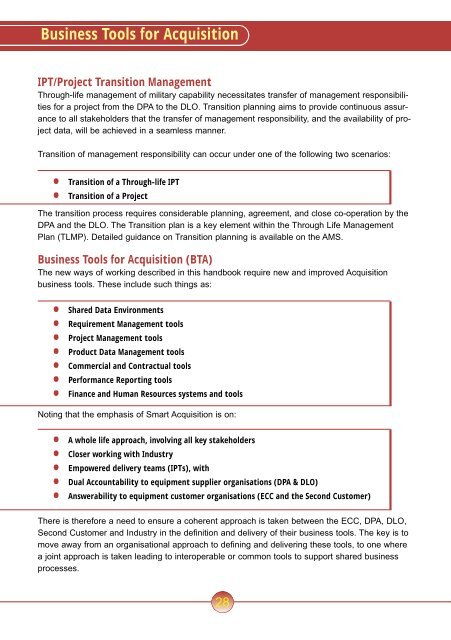The Acquisition Handbook
The Acquisition Handbook
The Acquisition Handbook
- No tags were found...
Create successful ePaper yourself
Turn your PDF publications into a flip-book with our unique Google optimized e-Paper software.
Business Tools for <strong>Acquisition</strong>IPT/Project Transition ManagementThrough-life management of military capability necessitates transfer of management responsibilitiesfor a project from the DPA to the DLO. Transition planning aims to provide continuous assuranceto all stakeholders that the transfer of management responsibility, and the availability of projectdata, will be achieved in a seamless manner.Transition of management responsibility can occur under one of the following two scenarios:Transition of a Through-life IPT• Transition of a Project<strong>The</strong> transition process requires considerable planning, agreement, and close co-operation by theDPA and the DLO. <strong>The</strong> Transition plan is a key element within the Through Life ManagementPlan (TLMP). Detailed guidance on Transition planning is available on the AMS.Business Tools for <strong>Acquisition</strong> (BTA)<strong>The</strong> new ways of working described in this handbook require new and improved <strong>Acquisition</strong>business tools. <strong>The</strong>se include such things as:Shared Data EnvironmentsRequirement Management toolsProject Management tools•Noting that the emphasis of Smart <strong>Acquisition</strong> is on:Closer working with IndustryEmpowered delivery teams (IPTs), with•Product Data Management toolsCommercial and Contractual toolsPerformance Reporting toolsFinance and Human Resources systems and toolsA whole life approach, involving all key stakeholdersDual Accountability to equipment supplier organisations (DPA & DLO)Answerability to equipment customer organisations (ECC and the Second Customer)<strong>The</strong>re is therefore a need to ensure a coherent approach is taken between the ECC, DPA, DLO,Second Customer and Industry in the definition and delivery of their business tools. <strong>The</strong> key is tomove away from an organisational approach to defining and delivering these tools, to one wherea joint approach is taken leading to interoperable or common tools to support shared businessprocesses.28
















